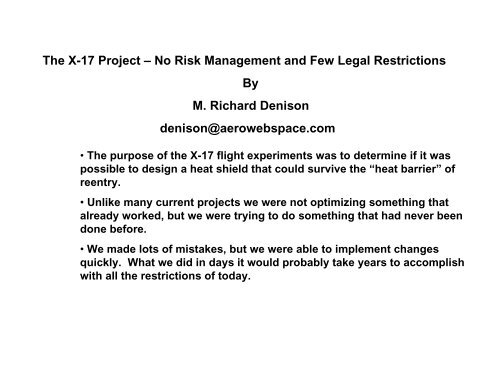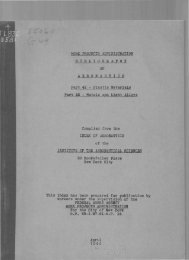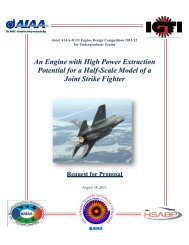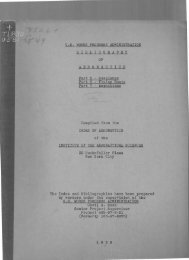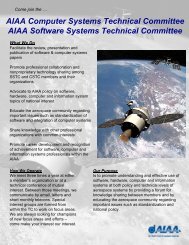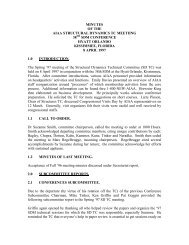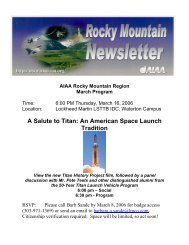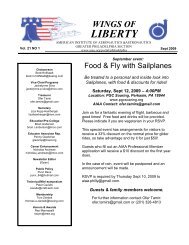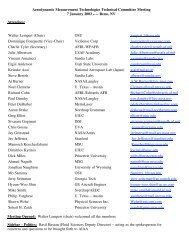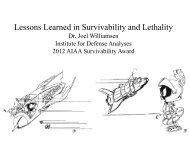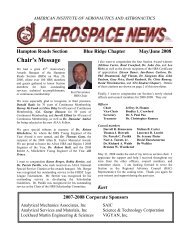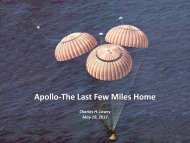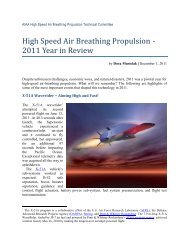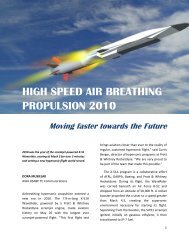The X-17 Project – No Risk Management and Few Legal ... - AIAA Info
The X-17 Project – No Risk Management and Few Legal ... - AIAA Info
The X-17 Project – No Risk Management and Few Legal ... - AIAA Info
You also want an ePaper? Increase the reach of your titles
YUMPU automatically turns print PDFs into web optimized ePapers that Google loves.
<strong>The</strong> X-<strong>17</strong> <strong>Project</strong> <strong>–</strong> <strong>No</strong> <strong>Risk</strong> <strong>Management</strong> <strong>and</strong> <strong>Few</strong> <strong>Legal</strong> Restrictions<br />
By<br />
M. Richard Denison<br />
denison@aerowebspace.com<br />
• <strong>The</strong> purpose of the X-<strong>17</strong> flight experiments was to determine if it was<br />
possible to design a heat shield that could survive the “heat barrier” of<br />
reentry.<br />
• Unlike many current projects we were not optimizing something that<br />
already worked, but we were trying to do something that had never been<br />
done before.<br />
• We made lots of mistakes, but we were able to implement changes<br />
quickly. What we did in days it would probably take years to accomplish<br />
with all the restrictions of today.
• <strong>The</strong> full-scale X-<strong>17</strong> employed three solid-<br />
fueled stages<br />
• <strong>The</strong> first stage was powered by a Thiokol<br />
Sergeant rocket which could produce a thrust<br />
of 48,000 pounds<br />
• <strong>The</strong> second stage employed three Thiokol<br />
Recruit rockets which could each produce a<br />
thrust of 33,900 pounds<br />
•<strong>The</strong> third stage was powered by a single<br />
Thiokol Recruit rocket which could produce a<br />
35,950-pound thrust by utilizing an enlarged<br />
exhaust nozzle<br />
• <strong>The</strong> first stage of the X-<strong>17</strong> was fired upward<br />
<strong>and</strong> the second <strong>and</strong> third stages were fired<br />
down toward the earth to simulate high speed<br />
reentry
<strong>The</strong> War Between the <strong>No</strong>rth <strong>and</strong> South<br />
• Lockheed Missile Division was located on the edge of Van Nuys Airport in two<br />
buildings called lean-to buildings because of the shape of the roof. <strong>The</strong>y really<br />
were nothing like the familiar greenhouse lean-to. <strong>The</strong>y were large two story<br />
buildings with a high bay area on the first floor, but they were referred to as the<br />
north <strong>and</strong> south lean-to.<br />
• <strong>The</strong> newly created Missile Division consisted of engineers, mostly from Lockheed<br />
Burbank, in the south lean-to <strong>and</strong> scientists, many from Los Alamos, in the north<br />
lean-to.<br />
• <strong>The</strong>re was a war between the north <strong>and</strong> the south.<br />
• On December 13, 1955 my first child, Linda, was born. On the same day there<br />
were big black headlines in the Los Angeles Times "20 Scientists Leave Lockheed"<br />
• I came to work h<strong>and</strong>ing out cigars <strong>and</strong> was greeted by George Sutton who said,<br />
"Life goes on"<br />
• <strong>The</strong> scientists headed by Ernie Krause, including Joe Charyk <strong>and</strong> Larry Kavanau,<br />
who had hired me two weeks before, left to form a new company called<br />
Aeronutronic in an ab<strong>and</strong>oned grocery store.<br />
• Larry, who got his PhD at Berkeley had recently hired Dan Tellep who just got his<br />
MS at Berkeley. At my level I shared an office with Dan Tellep. As you may know<br />
Dan eventually became CEO of Lockheed <strong>and</strong> arranged the merger with Martin.<br />
Dan Tellep <strong>and</strong> I stayed at Lockheed.
Peace in Our Time<br />
•<strong>The</strong> war between the north <strong>and</strong> south continued at a reduced level after<br />
the exodus. We were working on the Air Force X-<strong>17</strong> project which was<br />
sold to the Air Force by the departing scientists.<br />
• Larry Kavanau told me at a later time that he wrote the contract<br />
between Lockheed <strong>and</strong> the Air Force. <strong>The</strong> entire contract consisted of<br />
two pages.<br />
• It was decided that all of the three stage vehicle except the nose cone<br />
would be the responsibility of the engineers in the south lean-to.<br />
• Dan <strong>and</strong> I, residing in the north lean-to under the direction of the<br />
remaining scientists, were responsible for the nose cone.<br />
• Dr Lloyd Wilson was in charge of thermodynamics <strong>and</strong> heat transfer in<br />
the south lean-to. He was a very aggressive manager. He constantly<br />
tried to get Dan <strong>and</strong> me to join his organization. After he left Lockheed<br />
he became head of Brush Beryllium. Later he was one of the founders of<br />
RDA which was a spin off of R<strong>and</strong> Corp. During his time at RDA he was<br />
shot <strong>and</strong> killed by his wife
Second Stage Failure<br />
• <strong>The</strong> early test flights failed a few seconds after<br />
second stage ignition.<br />
• One day Dan <strong>and</strong> I took a look at the inter-stage<br />
hardware at the base of the second stage<br />
• I said to Dan. "How come those nozzles are<br />
buried so deep in the skirt? I was reading in<br />
Courant <strong>and</strong> Friedrichs that exhaust plumes<br />
exp<strong>and</strong> at altitude. I bet the exhaust plume is<br />
damaging the skirt"<br />
• We had several really great consultants available<br />
to us. One was Anatol Roshko from Caltech. We<br />
asked Anatol if this idea was right. He agreed
Convincing the Engineers in Charge<br />
• Convincing the engineers in the south lean-to was much more difficult<br />
• <strong>The</strong> project manager was Frank Bednarz <strong>and</strong> the person in charge of<br />
thermodynamic analysis was Lloyd Wilson.<br />
• Wilson insisted that he had tested the system <strong>and</strong> the flame only singed a<br />
screw. I asked where he did the test <strong>and</strong> he admitted it was on the ground.<br />
• I got pretty angry <strong>and</strong> we stormed into the assistant project manager’s office.<br />
Fred O’Green was a brilliant electrical engineer who later became head of Litton<br />
Industries. He wore hearing aids <strong>and</strong> often asked in a meeting, "Are you<br />
listening or do you have the gain turned down?"<br />
• Dan exhibited the diplomacy with O’Green that must have helped him rise in<br />
the company.<br />
• I think it was the Chief Engineer, Willis Hawkins, a very competent guy, who<br />
made the final decision<br />
• <strong>The</strong> result was that Lockheed would propose to change the inter-stage at the<br />
next meeting with Ramo Wooldridge technical managers for the Air Force<br />
• It took Lockheed about 10 days to make the change <strong>and</strong> fly again. Today it<br />
would take the better part of a year to do that. <strong>The</strong> result was about 20<br />
successful flights
Working with Ramo Wooldridge<br />
• <strong>The</strong> scientists at Ramo Wooldridge were headed by George Solomon assisted<br />
by John Sellars<br />
• Lester Lees of Caltech <strong>and</strong> George Carrier of Harvard were prominent<br />
consultants.<br />
• People that we had contact with were Budd Cohen <strong>and</strong> Jerry Fox<br />
• <strong>Project</strong> Manager Frank Bednarz, hated having them tell him what to do. He<br />
actually had an alarm system set up to warn him whenever they entered the<br />
plant.<br />
• We had review meetings in a large room with a huge round table which must<br />
have been built there because it could never be moved in or out<br />
• <strong>The</strong> meeting usually began with Frank entering late, slamming down his<br />
papers <strong>and</strong> declaring, "OK Let’s fight!"<br />
• A meeting that I remember had to do with Lockheed not being able to meet<br />
performance requirements. I am afraid that was my fault.
Turbulent Flow<br />
• <strong>The</strong> scientists at Ramo Wooldridge <strong>and</strong> ours that had left originally<br />
thought that it would be impossible for a vehicle to reenter the<br />
atmosphere unless it experienced only laminar flow<br />
• <strong>The</strong> X-<strong>17</strong> nose cone was designed as a nickel plated copper<br />
spherical shape with a 2 micro-inch finish to prevent transition to<br />
turbulence<br />
•<strong>The</strong> wall thickness was thinned out away from the stagnation point in<br />
accordance with the predicted drop off in heating rate in laminar flow<br />
•I wondered, "If it is turbulent can we h<strong>and</strong>le it?”<br />
• I developed a turbulent analysis based on what I had learned from Ed<br />
Van Driest <strong>and</strong> some ideas of Lester Lees on the effective Reynolds<br />
Number on a three dimensional body with variable flow outside the<br />
boundary layer<br />
• <strong>The</strong> results showed that unlike laminar flow where maximum heat<br />
transfer was at the stagnation point, in turbulent flow the maximum<br />
heat transfer would be near the sonic point of the flow outside the<br />
boundary layer analogous to the throat conditions in a nozzle<br />
• <strong>The</strong>refore we redesigned the nose cone with a constant wall<br />
thickness. This made it heavier than the original design <strong>and</strong> led to a<br />
degraded performance
Flight Measurements<br />
• <strong>The</strong> data that we obtained from the flights consisted of temperature<br />
measurements from an array of about ten thermocouples. We located the<br />
thermocouples very close to the surface of the nose cone.<br />
• To interpret the results we really wanted to obtain the heat transfer rate<br />
rather than just the temperature. We solved the transient heat transfer<br />
problem backwards to get the instantaneous heat transfer rate<br />
• Of course this problem is inherently unstable so that we got wiggly b<strong>and</strong>s<br />
of heat transfer rates. Nevertheless, it was obvious that the largest heating<br />
rate was near the sonic point.<br />
• To interpret flight data we used three IBM 650 computers <strong>and</strong> about a<br />
dozen women running Friden machines.<br />
• <strong>The</strong>re was a flight about every 10 days <strong>and</strong> there were a lot of people<br />
walking around with red eyes whenever we had a flight<br />
• Once something went wrong with the computers <strong>and</strong> the person who<br />
programmed them was not around. Bednarz moaned, "My whole project<br />
depends on a girl named Irene!"
<strong>No</strong>se Cone Flaws<br />
• Although we were allowing for turbulent flow the Ramo Wooldridge people were<br />
still hoping for laminar flow<br />
• One day John Sellars came over to inspect a nose cone that was about to fly<br />
• It was impossible to manufacture these nose cones without some flaws<br />
• John worked out an elaborate analysis for allowable length width <strong>and</strong> depth of a<br />
pit. <strong>The</strong> nose cone flunked<br />
• In order not to delay the flight someone got the brilliant idea of taking the nose<br />
cone to a dentist to fill the pit with gold<br />
• <strong>The</strong> nose cone flew <strong>and</strong> performed as usual
Fun Encounters with Our Friends at Ramo Wooldridge<br />
• We were going the fly a<br />
sphere cone configuration.<br />
• RW people were worried that<br />
the abrupt change in the radius<br />
of curvature at the joint<br />
between the two shapes would<br />
trigger turbulence.<br />
•<strong>The</strong>y gave us an algebraic<br />
power series formula for a<br />
transition<br />
• When we worked out the geometry it turned out that although the radius of<br />
curvature had a smooth transition the region had an unwanted bulge<br />
• <strong>The</strong>y called with new constants but it did not help<br />
• We ab<strong>and</strong>oned this exercise.
Stagnation Point Heat Transfer<br />
• Another fun episode had to do with trying to reduce stagnation point heat<br />
transfer<br />
• It was well known that stagnation point heat transfer on a sphere is<br />
inversely proportional to the square root of the sphere radius<br />
• <strong>The</strong>refore if we make a nose cone with a flat stagnation point region<br />
(infinite radius of curvature) there would be no heat transfer<br />
• Professor Wally Hayes was another of our consultants with whom we<br />
discussed this idea<br />
• He came back the next day <strong>and</strong> said, "I was thinking of your problem while<br />
taking a shower. As the water hit my nose I realized that it is not the body<br />
radius but the shock shape that governs the flow."<br />
• He worked out a simple theory that Dan Tellep implemented for analyzing<br />
various shapes<br />
• We designed some pretty weird shapes including a 5th degree paraboloid.<br />
This shape had a very flat nose <strong>and</strong> no discontinuity in radius of curvature,<br />
but the peak turbulent heating was still near the sonic point
Y-Axis<br />
1.4<br />
1.2<br />
1<br />
0.8<br />
0.6<br />
0.4<br />
0.2<br />
5th Degree Parabola<br />
0<br />
-1.2 -1 -0.8 -0.6 -0.4 -0.2 0 0.2 0.4 0.6 0.8 1 1.2 1.4 1.6 1.8<br />
X-Axis
Conclusion<br />
• We implemented changes in the inter-stage configuration, nose cone<br />
thickness, nose cone shape, <strong>and</strong> surface flaws without any delays to study<br />
risk or legal implications<br />
• Today these changes might take months or years to implement instead of<br />
days. <strong>No</strong>t only would time be lost, but the cost would balloon<br />
• Some changes should have been questioned. Bednarz wanted to set a<br />
range record so one time all three stages accidentally fired upward. <strong>The</strong><br />
third stage l<strong>and</strong>ed somewhere in Brazil<br />
• <strong>The</strong>re should be some compromise between the restrictions of today <strong>and</strong><br />
the efficiency of the X-<strong>17</strong> change implementation<br />
• <strong>The</strong>re is a big difference between optimization of something that works <strong>and</strong><br />
our task to do things that had never been done before
Appendix<br />
• <strong>The</strong> Appendix contains a portion of my original analysis of turbulent<br />
flow on blunt axisymmetric hypersonic vehicles which was never<br />
published in the open literature<br />
• This document was approved for release by Lockheed Martin <strong>and</strong> the<br />
Air Force on May 13, 2005<br />
• Publication was really in the stone age in 1956. We had no PCs <strong>and</strong> no<br />
word processors. I had a lot of help. From my h<strong>and</strong> written copy<br />
someone typed up the document on a Ditto Master. We had to be careful<br />
not to get that purple gel all over us. I had to write in the equations by<br />
h<strong>and</strong>. Calculations for the plots were done by those ladies with the<br />
Friden machines.
•To read the entire report go to www.aerowebspace.com In the<br />
center of the home page you will find "Read some original reentry<br />
reports" Click on that <strong>and</strong> you can find the entire report.<br />
• You will also find the original reports by Professor Wallace Hayes<br />
<strong>and</strong> Professor Lester Lees.


